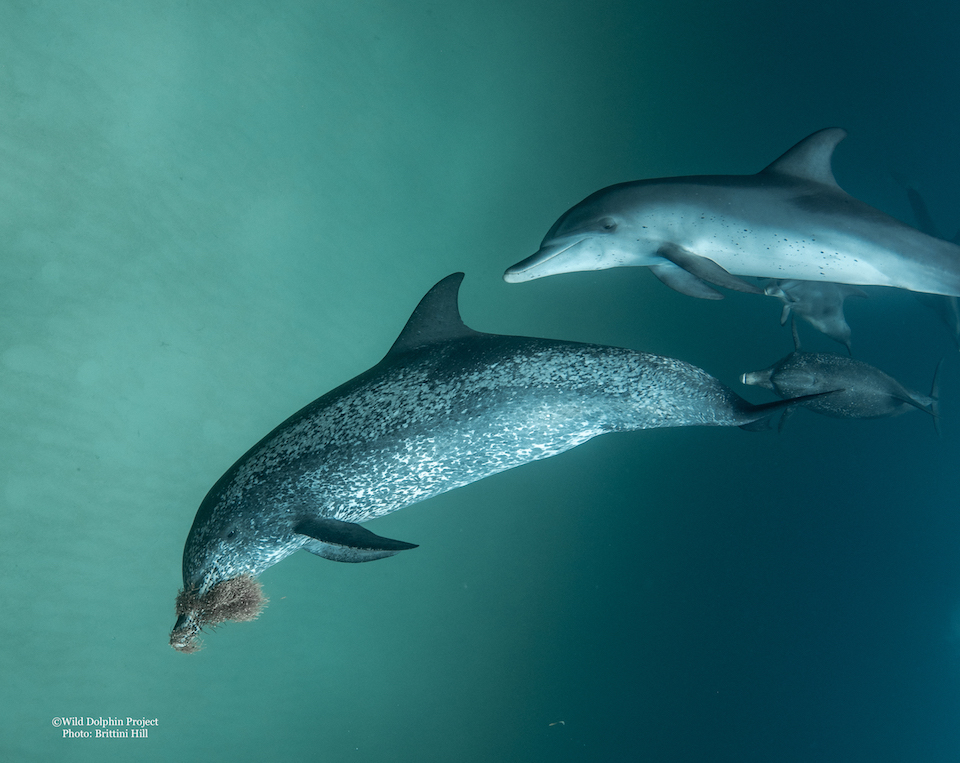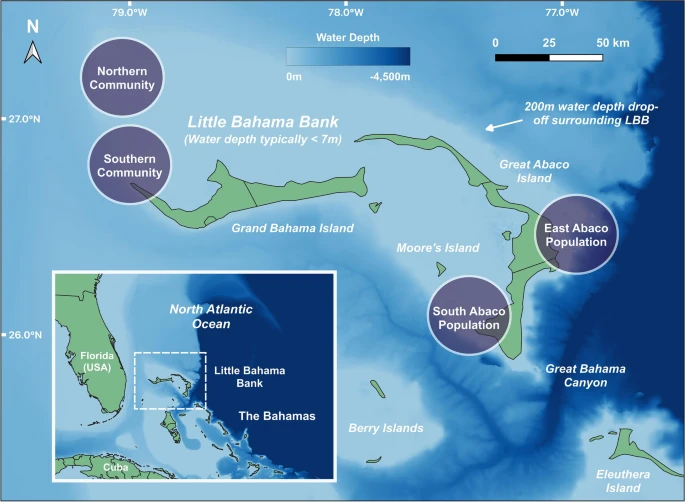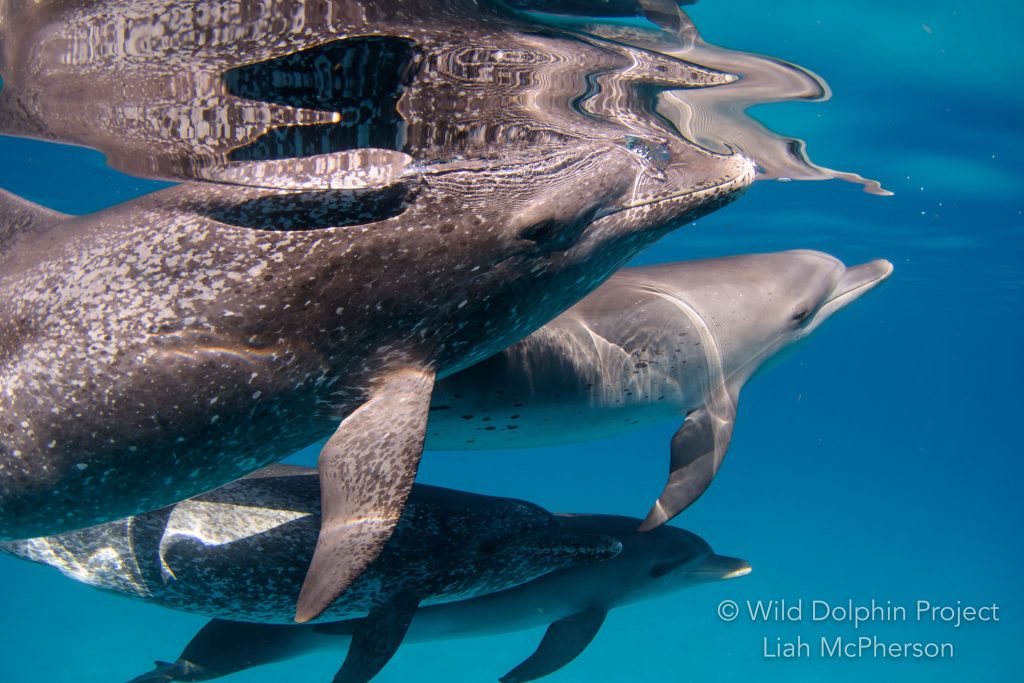
Hurricane Ian, 2022. Source: NOAA
Our hearts break to think of what Floridians are experiencing right now due to Cat 4 Hurricane Ian, one of the most powerful storms ever recorded in the U.S. As Ian tears across the state of Florida, leaving a path of destruction and loss, we wanted to share the impacts of hurricanes to wildlife as well. The animals we study in the Bahamas, for instance, have felt lasting impacts due to hurricanes.
What happens to dolphins during hurricanes?
Denise Herzing, Ph.D., and the Wild Dolphin Project have been monitoring the resident dolphin community who live on the shallow sandbank of Grand Bahama Island since 1985 and have experienced hurricanes that left lasting impacts on the community.
In 2004, Hurricanes Jeanne and Frances were two very strong cat 2/3 hurricanes that hit the Bahamas. Just like Hurricane Dorian of 2019, Frances hovered over the Bahamas for days before heading toward Florida. Additionally, both Frances and Jeanne hit within a few weeks of each other. When WDP returned the following summer for our normal field season, about 30% of both the spotted and bottlenose communities were gone.
“Whether they left, or died, we cannot say for sure,” said Cindy Elliser, Ph.D., research director and founder of Pacific Mammal Research. Elliser was formerly a research assistant with the Wild Dolphin Project for 10 years. Part of her doctoral research was examining the social relationships of the dolphins and what happened to those relationships following the hurricanes. “Based on their history and residency I believe they died, if they had moved I would expect to have seen them in a neighboring community (in the Abacos, Bimini or even FL), and none of those lost dolphins have been sighted again.”

Why would marine mammals equipped for a life at sea, die from hurricanes?
As mammals, dolphins must surface every few minutes to breathe. “Imagine having to swim in the middle of large waves, rain and massive wind, having to come to the surface in those conditions,” said Elliser. “If nothing else it would be exhausting. Some may have died in the roughness of the seas, or from exhaustion after.” Facing these conditions would be particularly challenging for new calves, which are often born in the fall and need to learn to swim, breathe and nurse.
Another possibility, said Elliser, is that the storms changed the availability of their food source or some aspect of the food web. Hurricanes kick up dirt and sand in shallow water, and this kills fish that essentially suffocate when their gills get clogged and the water is devoid of oxygen. Coral reefs and seagrasses also die when sunlight gets blocked by the stirred up water. “Since we did not see the animals until May (and the hurricanes were in Sept/Oct), we don’t know if it was an immediate loss, or a gradual one.”

Lasting Impacts
The impacts from hurricanes on dolphins extends beyond the presumed deaths. As social mammals, it can change their relationships and behavior. Within the entire community of about 100 animals (this number varies year to year), the spotted dolphins have smaller groups, called clusters. These clusters are based on their geographic range within the study area, as well as social relationships. Within those clusters, individuals seemed to come together and interact more with all members of their cluster, rather than separating by sex, age, or preferred companions. “I think makes sense,” said Elliser. “You band together when some are lost. This is important for safety, as well as to continue the behaviors that are required for continued survival of the group, like mating and hunting.”
The bottlenose dolphins had a bit of a different story, says Elliser. They lost about 30 percent of their community, but had an influx of immigrants of about the same amount. And then, the community of individuals split into two smaller groups, comprised of both the original residents and new immigrants. We noticed little overlap between the two smaller groups, says Elliser. So, while the spotteds came together into a larger group, the bottlenose separated.
Lastly, after the hurricanes, even the relationship between the two species changed. The spotted and bottlenose dolphins regularly interact in the Bahamas and event fight. Following the 2004 hurricanes, we witnessed fewer mixed encounters. One particularly overt behavior — called side-mounting — that the bottlenose males use during aggressive fights with the spotteds wasn’t observed again until 2009. “It is likely that although these mixed species encounters are important for the ability to coexist on the sandbank together, so they continued, the focus of the encounters changed as each species had more pressing matters of stabilizing their own communities after such large demographic disturbance,” said Elliser.
Changing Seas
Climate change appears to be contributing to the observed increase in intensity and frequency of at least some forms of extreme weather events, including hurricanes according to the National Academy of Sciences. The dolphins of the Bahamas dodged Ian, but it’s likely they will face more storms in the years to come.
In a recent study in Mammalian Biology, marine mammal scientists explored whether hurricanes may have influenced the apparent survival rates of calves, juveniles or adults in the South Abaco bottlenose dolphin population, and which features of hurricanes (frequency, intensity, proximity) may best explain any effect.
The results are alarming. They found evidence that survival was indeed linked to hurricane activity, leading to increased morality and/or emigration. For example, estimated survival declined by 9% in adults, 5% in juveniles and 36% in calves (0.970 in 1997, to 0.606 in 2013).
According to the authors, “simulations of an assumed isolated South Abaco population showed that declines would lead to extinction within decades, even under the most optimistic scenario.” However, they note that future work should figure out in the South Abaco population is a source or sink for the entire Little Bahama Bank dolphin community.
Estimated annual birth rate was 0.278 (95% CI: 0.241–0.337). We found strong support for a decline in apparent survival for all age-classes. Estimated survival declined by 9% in adults (0.941 in 1998, to 0.855 in 2013), 5% in juveniles (0.820 in 2000, to 0.767 in 2013) and 36% in calves (0.970 in 1997, to 0.606 in 2013). Evidence that survival was influenced by repeated hurricane activity leading to increased mortality and/or emigration was stronger for calves and juveniles than for adults. PVA simulations of an assumed isolated South Abaco population showed that declines would lead to extinction within decades, even under the most optimistic scenario.

Map showing the approximate location of the South Abaco bottlenose dolphin population on Little Bahama Bank (LBB; northern Bahamas) in relation to other local populations (after Rogers et al. 2004). Bathymetry data: GEBCO Compilation Group (2020). (Source: Coxon et al 2022)
Around the World
How dolphins fare after a catastrophic event is likely to vary considerably between locations and will depend on both the resilience of the population and of the ecosystem, as well as the severity of the event (Fazioli and Minzer, 2020).
In Galveston Bay, a estuary in Texas with a resident population of bottlenose dolphins, Hurricane Harvey inundated the region with record-breaking rainfall in August 2017, altering the salinity of the bay. After this event, many of the dolphins shifted habitats from shallow open bay to deep channels where salinity increased with depth, according to a study in the journal Esutaries and Coasts. While most dolphins evacuated the upper portion of the bay, many remaining dolphins shifted habitats from shallow open bay to deep channels where salinity increased with depth.
In Mississippi Sound, post-Katrina, researchers observed short and long-term effects from the storm including higher calf mortality (that was compensated later by higher-reproductive rates), a slight increase in the number of juvenile stranding events, and changes in feeding behavior and locations (Fazioli and Minzer, 2020).
Yet, in the Charlotte Harbor estuary of Florida, Hurricane Charley had no lasting impact on dolphin population numbers, despite the 2 to 3-month decrease in dissolved oxygen and reduced fish within the estuary (Fazioli and Minzer, 2020).
“As more and more things are changing, and changing fast, the plasticity of a species will be critical in their survival. Luckily dolphins are good at this, so it bodes well for their future as a species,” said Elliser. “But at some point plasticity won’t be enough, and we need to make sure we don’t take things to a tipping point where we can’t come back.”

